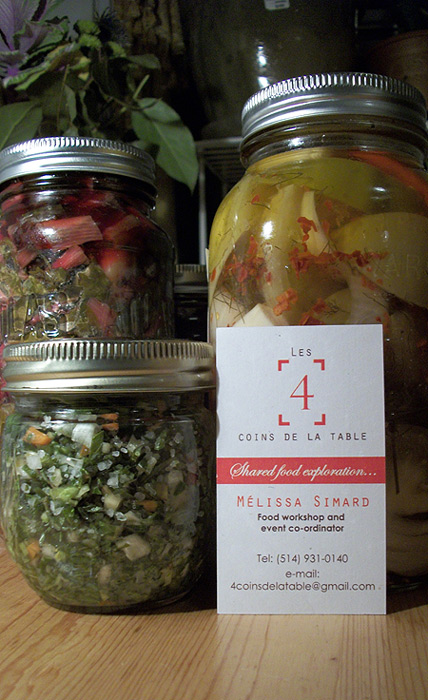Every year at the harvest I go pick what’s left in the fields of D-Trois Pierres and come back to Montreal to can part of the harvest left-overs with the Réseau d’entraide and the other half with my dinner club. This year D-Trois Pierres didn’t have any surplus […]
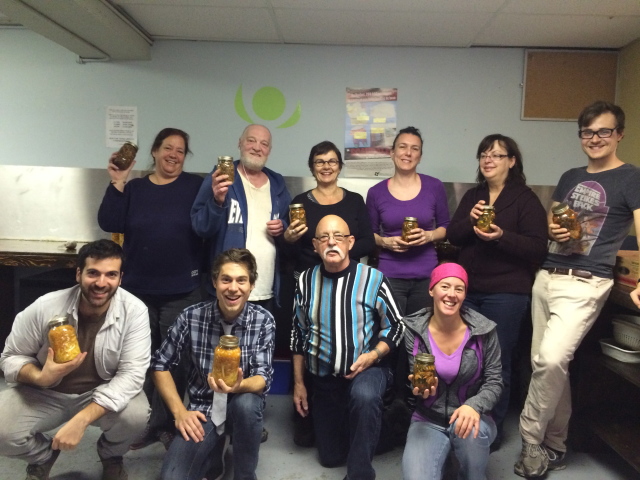
Every year at the harvest I go pick what’s left in the fields of D-Trois Pierres and come back to Montreal to can part of the harvest left-overs with the Réseau d’entraide and the other half with my dinner club. This year D-Trois Pierres didn’t have any surplus in the fields, so my whole model was thrown off kilter a few weeks before the end of the growing season. I have also been working part-time at Chez Doris (a day centre for homeless women) and giving cooking workshops once a month with CFAD (Continuité famille auprès des détenues). That meant that I had more partners to make preserves with and less produce to make it with!
I started by sending an e-mail to Lufa and thanks to the wonderful Erica Dancose who contacted their partners we received: cucumbers, peppers, carrots, beets amongst other things!

The Goods- Thank you to the farms that donated!
Then I got in touch with my close friend and celebrity organic urban farmer Judith Colombo and she hooked me up with La Ferme Belle Roche and La ferme co-op des Champs qui chantent in Lachute. We drove out with my mom who was visiting and picked parsnips, carrots, kale, herbs, swiss chard, green tomatoes, sorrel and hot peppers! Heather from Le co-op des champs qui chantent even had a hot bowl of soup for us! I think it was colder at the beginning of November than it is now!

Here is Judith Colombo farmer extraordinaire, my Mom and Dina Honke blogger at http://oliveoilandlemons.com/montreal-going-green-melissa/ all on the Montreal Living Table: healthy and sustainable food tour (on the roof of Santropol Roulant)
This year was bigger and badder. Changing farms and enlarging the different benefitting organizations allowed me to involve more wonderful people in the activities!

Simon from La Ferme Belle Roche and fresh herbs and hot peppers!
Our first day of canning with fresh, local, organic produce took place at the Réseau d’entraide de Verdun. We did it with Gabriel’s collective kitchen group, plus some of the former participants in my workshops, Suzanne Bruneau and Maxime Gaboriault from the dinner club and the esteemed secret weapon Sébastien Bureau of Mannanova who is also the food scientist of RISE kombucha. People left with a super garlicky and spicy kale kimchi fermenting, a ruttabega, cabbage and carrot kraut fermenting, salted herbs and a green fruit relish. There was 15 of us and it was such a heart-warming and pantry-filling experience.

Sébastien Bureau- food scientist and fermentation guru…getting turned on by the turnip, carrot and cabbage kraut by the looks of it!

Gabriel- collective kitchen co-ordinator at the Réseau d’entraide who so kindly welcomed us in his fold to make preserves!

Heather: farmer and co-founder of Le Co-op des Champs qui chantent! Thanks for the beautiful vegetables!

Erica Dancose who managed to snag us a variety of veg to preserve from some of Lufa’s numerous partners!
The second preserve session was with ladies from CFAD and from Chez Doris at CFAD. We made chow chow and pickled carrots. We also had a nice time together and the staff from CFAD pitched in too.

Dinner Club represent!

Kale kimchi- spicy and garlicky being joyfully mixed!

Kale Kimchi ready to ferment
I’d like to sincerely thank Le Co-op des champs qui chantent, Lufa and La Ferme Belle Roche for contributing fresh local, organic, in-season vegetables towards those who have less instead of the usual processed non-perishables, and also contributing to an experience where people learn about canning, salting, pickling and fermenting. Preserving is a highly social activity and it was nice to see people from each organization rubbing shoulders with each other, with dinner club members and even with Sébastien the food scientist! Thank you also to the organizations that housed the activity and contributed to cover the cost of the other ingredients and the mason jars! See you next year!

Green tomato fruit relish- Catsup aux fruits de tomates vertes

Turnip, carrot and cabbage kraut ready to ferment for 6 weeks!

End of the season at le Co-op des champs qui chantent
Conserving Autumn: Canning, Fermenting and Salting it!
Hot vegetables in brine, pickled spiced beets, salted herbs and ketchup
The weekend of October 21st to the 23rd was spent canning, salting and starting vegetables fermenting. Friday the 21st of October, Judith Colombo, elite member of the 4 COINS DE LA TABLE dinner club for […]

Hot vegetables in brine, pickled spiced beets, salted herbs and ketchup
Conserving Autumn: Canning, Fermenting and Salting it!
Hot vegetables in brine, pickled spiced beets, salted herbs and ketchup
The weekend of October 21st to the 23rd was spent canning, salting and starting vegetables fermenting. Friday the 21st of October, Judith Colombo, elite member of the 4 COINS DE LA TABLE dinner club for many years, went into the fields of D-Trois Pierres in Cap-St-Jacques and harvested cases of vegetables and herbs for the dinner club to transform. She is the agricultural co-ordinator of the largest organic farm on the island of Montreal, and, although she said this was a terrible year, boy she grew some beautiful vegetables. We had picked the date 3 weeks prior, and it was the very end of the season and the organic food hampers. Each member of the dinner club planned and brought the ingredients to transform a vegetable or two. Judith made a salsa with the tomatoes, peppers, onions and hot peppers. Jeremy made swiss chard in a highly seasoned lemon and garlic oil and vegetables and hot peppers in brine. Suzanne, Tisha and Majiza (mother and daughters) made sweet and spicy beets and started a beet sauerkraut, Ameur salted herbs, Gisèle pickled root vegetables and Mario (my blog techie) made a Portuguese tomato jam with porto and cinnamon. I bought some apples and nectarines and used the farm’s onions, celery and tomatoes to make catsup aux fruits (fruit ketchup). When I got home, I started a cabbage sauerkraut and a kale kimchi fermenting.

some of the beautiful vegetables Judith Colombo grew at D-Trois Pierres
We made 72 jars of stuff in an evening, and 3 buckets of cellar vegetables are still fermenting. It was a party of abundance, marking the changing of the seasons, and it was heart-warming to send each other off with a dozen jars for each household. The preserves are not only useful and delicious, but a reminder of the seasons, local production and the people that made the preserves with love.

Nectarines and tomatoes scalding in order to peel.

Just like in the old school
We were also reminded of how much work agricultural life entailed back in the day. We canned from 4pm to midnight, and we were numerous. However, a woman doing it by herself after milking the cows, tending the fields, cooking and caring for her children…I can guarantee she didn’t have time to complain about the change in temperature or ponder what to do with her life. Like back in the day, all of the women did all of the organizing, delegating tasks, gathering mason jars and were ready to work when they got there. The girls started work at 4pm, Judith around 1pm picking the vegetables and the guys trickled in around 6:30, 7 o’clock ready to drink beer. Jeremy knew what the work entailed as he does product transformation for Wing Noodle, but the other guys insisted we were there “to have a good time”. At the end of the night, everyone was wiped, but we were really happy with what we’d done. I think some actually realized that, although it was work, work does not always mean suffering. It is actually key in developing one’s sense of purpose, accomplishment and self-esteem. When you make the effort, you get the pay-off. Avoiding the effort is even more painful than digging-in. It is also nice to attack the work as a group, make a party out of it and help the other with their task. Each person has different strengths to offer.

Cabbage Patch- Mommy is that where sauerkraut comes from?
The canning was not done. I had a workshop with the Réseau d’Entraide de Verdun as well. We went out to D-Trois Pierres (in Cap-St-Jacques) the morning of Sunday October 23rd and picked carrots, beets, cabbage, herbs, rutabagas, white turnips, and some green tomatoes. There were 2 families and an individual. There was a buzz in the air. It’s exciting getting out of the city, and it was beautiful out. When we got back to the Réseau d’Entraide de Verdun, we made a fast sauerkraut, catsup aux fruits (fruit ketchup), salted herbs and pickled beets.

I loosening carrots from the ground
Some of the people that came out had never been to a farm before, and, before they came to the farm, some of the kids didn’t really understand that a carrot grew under the ground. They were mesmerized by the farm animals and just generally enraptured by the countryside. As with the dinner club, they also found out that a day of picking vegetables and conserving them is really hard work. Surprisingly, the kids out-toughed the adults, and it was a really magical…and productive day.

La verdure

First time Canners

Ladybugs that followed us back to Verdun, at one point we realized there was about twenty of them on the fluorescent lights at Réseau d'Entraide

Rosy cheeks- a little tired, still going hard
The weekend of Oct. 21st to the 23rd was a work sprint like in the old school. It didn’t pay, but it stocked the shelves in quite a few pantries for winter and got together dear friends from the dinner club and other Verdun citizens that wanted to learn to preserve the fruit, vegetable and herb fall bounty. We were put back in contact with the Earth, and we remembered where vegetables come from, that people grow and harvest them and the work that goes into transporting and preparing them. It ended up being a celebration of the seasons and a breath of fresh air and solidarity. Stay tuned for more cooking parties of the sort.

The troops on the move

I've never seen so much Catsup aux Fruits in my Life!

Modern Canning
Anyone who knows me knows I have a bit of a soft spot for salt, spices, aromatics and hot food. I grow a variety of herbs and at the end of the season, I have a surplus. There are many things we can do with the masses of left-over herbs: drying, pesto, […]

Anyone who knows me knows I have a bit of a soft spot for salt, spices, aromatics and hot food. I grow a variety of herbs and at the end of the season, I have a surplus. There are many things we can do with the masses of left-over herbs: drying, pesto, perfumed oils and salted herbs. I tend to dry a bit, make a bit of pesto and make salted herbs. Every year, the thing I have the most of is basil. I like pesto as much as the next girl, but I like other things too. I’ve started making pestos with a few different nuts just to switch it up a bit, but I’ve also started making my own blends of salted herbs besides the Bas-du-Fleuve style. I make Calabrese, Provençal, and Indonesian-style salted herbs now. These are recipes I made-up. They are my way of grouping and preserving a concentration of flavours from a certain culinary tradition, so I can add their essence to a dish. Salted herbs are good for soups, stews, sauces, salad dressings, or anywhere you want to put salt and flavour!
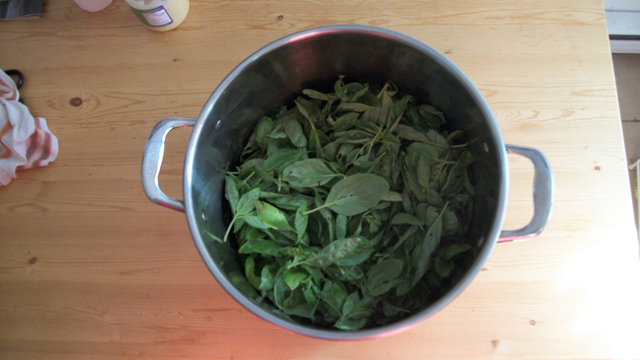
When I did a cooking internship in Calabria with Luigi Quintieri at La Tavola di Melusinda he showed me that the key flavours in Calabrian cuisine were mint, garlic, basil, pepperoncino (hot peppers) and lemon zest. There were alot of Moorish tones to Calabrian food.
Here is my recipe for Calabrese salted herbs
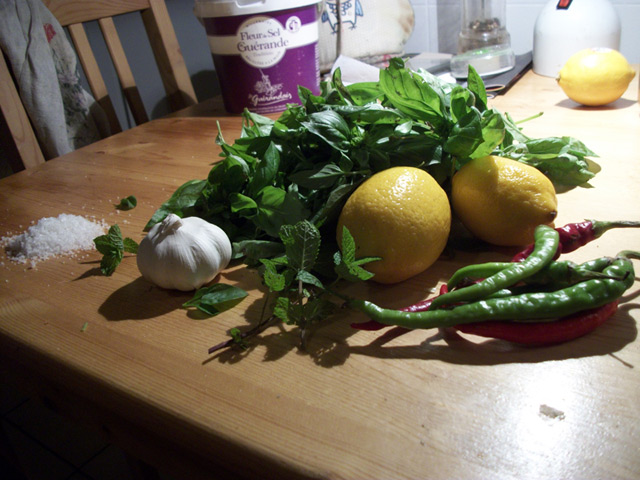
Salt, garlic, mint, basil, lemon zest, pepperoncino
Calabrese salted herbs
400g of basil
200g of mint
1 head of garlic
zest of 3 lemons
2 to 4 hot peppers of choice (you can use dried chilis of you want too)
1/4- 1/3 c. of sea salt of choice
a little olive oil or water to make the paste smoother

Wash the basil

Chop the garlic and the hot peppers

Zest the lemons

Blend everything in the food processor adding a little water or olive oil.
Wash the herbs. Slice the garlic and hot peppers. Zest the lemons. Put all ingredients in a food processor. Process until smooth, adding a little water or olive oil. Mix in the desired amount of salt. I use grey salt or fleur de sel, but you can use something much cheaper as you will probably use the salted herbs for cooking and not finishing a dish. If you want to do an even more Moorish version (pardon the pun), you can replace the lemon zest with minced preserved lemon. Enjoy! Thank you Luigi for the inspiration!
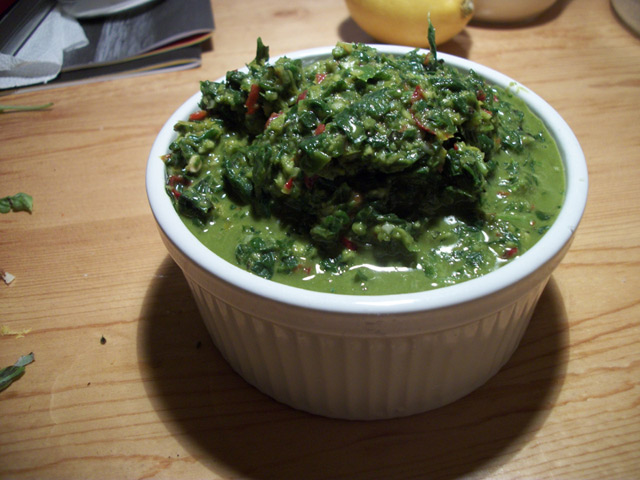
CATEGORIES
Archives
- February 2022 (1)
- October 2020 (2)
- September 2020 (1)
- January 2016 (1)
- January 2015 (1)
- October 2014 (1)
- February 2014 (1)
- January 2014 (1)
- July 2013 (1)
- June 2013 (2)
- May 2013 (1)
- March 2013 (1)
- February 2013 (2)
- November 2012 (1)
- September 2012 (1)
- June 2012 (2)
- May 2012 (1)
- April 2012 (1)
- March 2012 (1)
- February 2012 (1)
- January 2012 (2)
- December 2011 (1)
- November 2011 (4)
- October 2011 (4)
Popular Tags
'Round Table Tours Asian breakfast business prolfiles cabbage canning Community Europe Events farms fermentation Fitz & Follwell Food & Story Food history Food Production food tours fresh juices Friends gastronomy health herbs History Italy kimchi Meal exchange Nuart organic preserves public Quebec restaurant Rumble & Shakes Réseau d`Entraide de Verdun salt smoothies spicy Tours de la Table Vegan youtube videos


